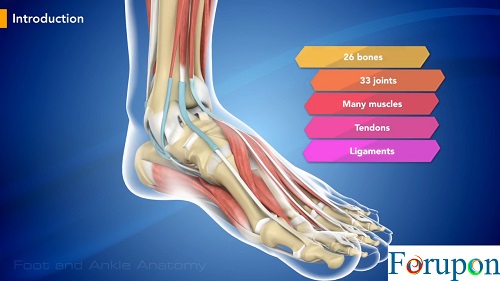Ankle Anterior: Muscles and Ligaments
Ankle Anatomy: There are many different muscles and ligaments in the ankle, which give the ankle strength, flexibility, and range of motion.
The foot and Ankle Anterior are quite complex. The foot consists of thirty-three bones, twenty-six joints, and over a hundred muscles, ligaments, and tendons.
These all work together to bear weight, allow movement and provide a stable base for us to stand and move on.
Major ligaments of the ankle

Anterior view of ankle ligaments.
Ligaments are a type of soft tissue that is made up mostly of collagen. Ankle Anatomy. Ligaments have low vascularity, which means they do not receive much blood flow. This lack of blood flow makes ligaments slower to heal than other types of soft tissue. Ankle Anatomy.
Unlike tendons, which connect muscle to bone, ligaments connect bones to other bones. Ankle Anatomy.

Posterior view of ankle ligaments.
There are several major ligaments in the ankle:
- Three ligaments on the outside of the ankle make up the lateral ligament complex, as follows:
- The anterior talofibular ligament (ATFL), which connects the front of the talus bone to a long bone in the lower leg called the fibula
- The calcaneofibular ligament (CFL), which connects the calcaneus, or heel bone, to the fibula
- The posterior talofibular ligament (PTFL), which connects the rear of the talus bone to the fibula
- The deltoid ligament is a thick ligament that supports the entire medial, or inner, side of the ankle and is made up of parts:
- Anterior tibiotalar ligament (ATTL)
- Posterior tibiotalar ligament (PTTL)
- Tibiocalcaneal ligament (TCL)
- Tibionavicular ligament (TNL)
- The anterior inferior tibiofibular ligament (AITFL), which connects the tibia to the fibula
- Two posterior fibular ligaments, which crisscross the back of the tibia and fibula:
- The posterior inferior tibiofibular ligament (PITFL)
- The transverse ligament
- The interosseous ligament, which rests between the tibia and fibula and runs the entire length of the tibia and fibula, from the ankle to the knee
The various ligaments that surround the ankle together help form part of the joint capsule, a fluid-filled sac that surrounds and lubricates articulating joints.
Major muscles of the ankle
There are also multiple muscles in the ankle that can be strained, as follows:
- The peroneal muscles (peroneus Longus and peroneus Brevis), are on the outside edge of the ankle and foot. These muscles allow the ankle to bend downward and outward.
- The calf muscles (gastrocnemius and soleus), are connected to the calcaneus via the Achilles tendon. The tightening and relaxing of the calf muscles enable the ankle to bend downward and upward.
- The posterior tibialis muscle supports the arch of the foot and enables the foot to turn inward.
- The anterior tibialis muscle enables the ankle and foot to turn upward.1
The complexity of the ankle’s muscular and ligament structure creates many possible opportunities for injuries when the ankle is pushed beyond its normal range of motion. Ankle Anatomy.
The ankle joint, also known as the talocrural joint, is a synovial joint that connects the bones of the leg, the fibula, and the tibia, with the talus of the foot. Ankle Anatomy. It is a complex hinge joint composed of two articulations.
It is often described as a tenon and mortise joint, as the tibia and fibula act as a mortise and form a notch in which the body of the talus fits, acting as the tenon.
The main action of the ankle joint is to allow dorsiflexion and plantar flexion of the foot, as well as some degree of pronation and supination with subtalar and midtarsal joints. The joint also acts as a shock absorber as the heel strikes the ground during the first phases of gait. Ankle Anatomy
The distal end of the tibia articulates with the trochlea of the talus, a pulley-shaped rounded superior articular surface.
- 1. Sechrest, R. Ankle Anterior: a patient’s guide. eOrthopod.com: http://www.eorthopod.com/ankle-anatom/topic/159. Accessed November 17, 2014.


Comments are closed.